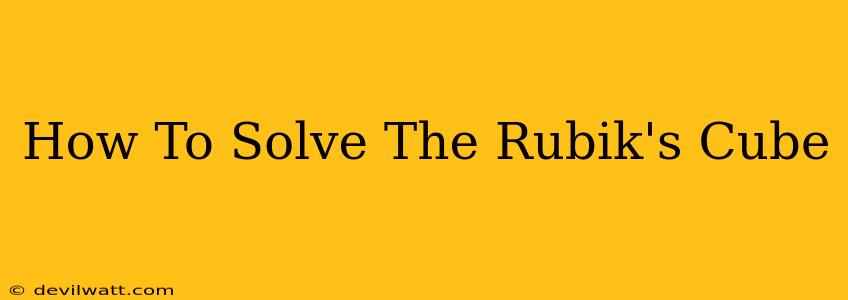The Rubik's Cube. That frustrating, yet endlessly fascinating puzzle that has captivated millions. For beginners, it can seem impossible, a chaotic jumble of colors. But fear not! This guide will break down the process step-by-step, making solving this iconic puzzle achievable for everyone. We'll cover the fundamental methods, ensuring you can conquer the cube and join the ranks of Rubik's Cube solvers.
Understanding the Rubik's Cube Notation
Before diving in, it's crucial to understand the standard notation used to describe cube movements. This makes learning algorithms and following instructions much easier. Here's a quick rundown:
- F (Front): The face you're looking at.
- B (Back): The face opposite the front.
- R (Right): The face to your right.
- L (Left): The face to your left.
- U (Up): The face on top.
- D (Down): The face on the bottom.
A prime symbol (') after a letter indicates a counter-clockwise rotation of that face by 90 degrees. For example, R' means turning the right face counter-clockwise. A '2' after a letter indicates a 180-degree rotation. For example, F2 means turning the front face 180 degrees.
The Beginner's Method: Step-by-Step
The beginner's method is a layered approach. We'll solve the cube layer by layer, starting with the white cross, then the white corners, the middle layer, and finally the yellow face.
Step 1: Solving the White Cross
This is the foundation. Your goal is to get a white cross on the top face (the Up face, or U face), with the edge pieces correctly oriented in relation to their center pieces. This might require a bit of intuition and trial and error at first, but don't worry; it gets easier with practice.
Step 2: Solving the White Corners
Once you have the white cross, the next step is to position the white corner pieces to complete the first layer. There are specific algorithms (sequences of moves) to help you achieve this, but initially, you can often achieve it through intuitive manipulation.
Step 3: Solving the Middle Layer
This step involves bringing the four edge pieces of the middle layer into their correct positions. Again, algorithms exist to facilitate this process, but some beginners find they can solve this layer through careful manipulation.
Step 4: Solving the Yellow Cross
Now we tackle the yellow face. The goal is to create a yellow cross on the top face. There are algorithms to help with this, and they become crucial as you progress.
Step 5: Orienting the Yellow Edges
After forming the yellow cross, you'll need to orient the yellow edges so that the entire top face is yellow. Algorithms are key here for efficiency.
Step 6: Permuting the Yellow Corners
The final step involves correctly positioning the yellow corners to complete the cube. Again, specific algorithms are very useful here.
Mastering Algorithms: The Key to Speed
While intuitive manipulation can get you started, mastering algorithms is crucial for speed and efficiency. Many online resources offer video tutorials and written instructions for the algorithms needed for each step. Practice is key – repetition helps these sequences become second nature.
Resources and Further Learning
Numerous online resources exist to assist you in your Rubik's Cube journey. YouTube is a fantastic source for visual tutorials, breaking down each step and algorithm with clarity. Websites and forums dedicated to speedcubing offer advanced techniques and tips for those looking to push their skills further.
Beyond the Beginner's Method: Advanced Techniques
Once you've mastered the beginner's method, a whole world of advanced techniques opens up. Methods like CFOP (Fridrich Method) and Roux offer significantly faster solving times. These methods involve more complex algorithms and require a higher level of understanding and practice.
Solving a Rubik's Cube is a rewarding experience. It tests your patience, problem-solving skills, and spatial reasoning. Don't be discouraged by initial challenges. With practice and persistence, you'll be twisting and turning your way to a solved cube in no time!

